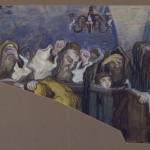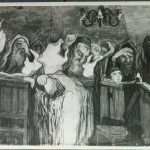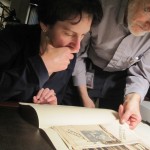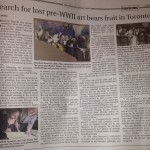On 30 October 2013, Canadian Jewish News ran an article about my visit to the University of Toronto, “Search for lost pre-WWII art bears fruit in Toronto.” The piece was written by Fern Smiley. Here is a transcript of the article. Below please find all three images that appeared in the print version of the story.
Elizabeth Rynecki has always wondered what the watercolour, Prayer, painted by her great grandfather, Moshe Rynecki, looked like in its entirety. At a talk she gave earlier this month at the University of Toronto’s Centre for Jewish Studies, titled “Chasing Portraits: a Great-Granddaughter’s Search for her Lost Art Legacy,” she displayed a slide of the watercolour.
The intense energy of the congregants praying the Shema in the soulful painting abruptly halts on two opposite corners. One third of her image was missing, twice diagonally slashed as if amputated to save the rest.
Later, following her presentation, in a remarkable turn of events, Rynecki would find out just what the original watercolour looked like. Rynecki’s efforts to find her great-grandfather’s paintings that were lost in the Holocaust are partly affected by her graduate work examining the voice of the second generation within Holocaust discourse.
Through the art of her great grandfather and its assemblage, Rynecki would find for herself meaning in the recovery of memory, a responsibility she has fully embraced in recent years through social media and documentary filmmaking.
Rynecki, who earned a master’s degree in rhetoric and speech communication at the University of California, Davis, and now lives in Oakland, Calif., knows little about her family’s story of survival.
What she does know is that at the outbreak World War II, Moshe Rynecki became concerned about preserving his life’s work – more than 800 paintings and sculptures- and that in the early days of the war he divided his oeuvre into bundles and hid them in an around Warsaw in an effort to protect them.
Moshe perished in Majdanek, and after the war the family recovered approximately 100 paintings in the cellar of a home in Warsaw’s Praga district.
Rynecki’s works –each depicting Jewish spiritual, communal, or commercial life in pre-war Poland- have seeped into museums and private hands.
One story she told was of partisan fighters who, on their walk back into Poland from Russia bought a bundle of paintings from a farmer who had stored the works during the war, which is why she came to Toronto – to visit the home where four of her great-grandfather’s paintings hang, beautifully framed, and treasured by a family who feel fortunate to have them.
Rynecki described the difficulties facing most heirs around the issues of asserting claims and talked about her choice to take a different route- not as a claimant but as an historian.
While it’s possible that much of Moshe Rynecki’s extant oeuvre has been stolen, this can’t be easily proven. Since Moshe’s work was never recorded or catalogued, it is impossible to prove whether paintings that surface at auctions, for example, came from the bundles.
As an art historian, Rynecki can search for her great-grandfather’s paintings, establish relationships with those who have his pieces, and potentially learn the stories that tie all of those who have experienced the work into a larger narrative.
In return she receives gifts, and that night at her talk,Prof. Barry Walfish gave her several more.
After the questions ended, he raised his hand and explained to Rynecki and the audience that the University of Toronto Library, where Walfish works as Judaica Specialist, holds handwritten letters of her great-grandfather as well as more than a dozen photographs of his paintings. Among them was a photo of the damaged painting she showed during her talk.
In the rain, after a long lecture, Walsfish accompanied Rynecki to the Thomas Fisher Rare Book Library, where he opened two archival boxes from the Otto Schneid archives.
Schneid, a European born Polish painter, sculptor, and historian, wrote a book on modern Jewish art in the Diaspora. In his research he solicited autobiographies and photos of artwork from dozens of Jewish artists in Europe, including Moshe.
In 1938, after Germany’s annexation of Austria, the printing f his authoritative book by his Viennese publisher was halted by the Nazis. Schneid fled Poland for Palestine but never saw his book in print. A Hebrew version which he prepared in Israel and was ready for publication in 1957 also never saw the light of day. The unpublished manuscripts, in German and Hebrew, along with all the background material he collected, were gifted to the Fisher Library by his widow, Miriam, in 2002.
Out of the boxed archives came more than a dozen photos of paintings Rynecki had never seen before, including one called Kabbalist, and one haunting deathbed scene of Moshe’s own father, as well as the intact photographic reproduction of his watercolour, Prayer, and a handwritten letter in Yiddish from Moshe to Schneid, introducing himself, which begins: “I was born an artist …”
“I am delighted I was able to help Elizabeth in her quest for information on her great-grandfather’s artistic legacy,” Walfish said later.
“The Schneid archive is a wonderful resource for the study of Jewish art in Europe in the interwar period. Many of the artists included in it perished in the Holocaust. I hope that this discovery will help get the word out and bring more scholars and seekers to our door.”
You can find out more about Rynecki and her search for her great-grandfather’s works on her website, www.rynecki.org
Fern Smiley is an advocate for Holocaust era art restitution and was an adviser to the former Canadian Jewish Congress.
[Black and white photo Courtesy of the Thomas Fisher Rare Book Library, University of Toronto.]
- CJN 10.30.2013: “Search for lost pre-WWII art bears fruit in Toronto”



